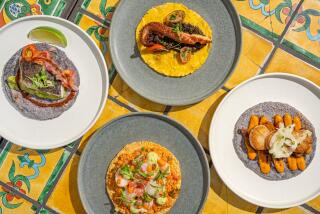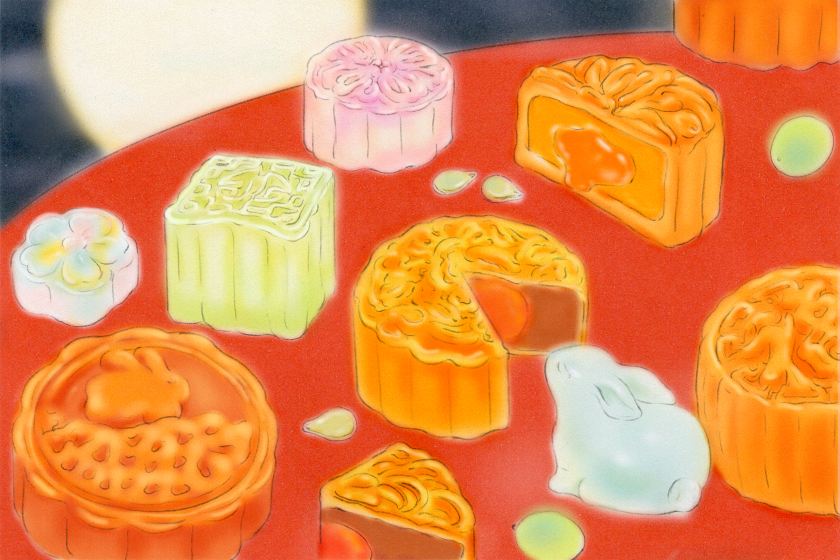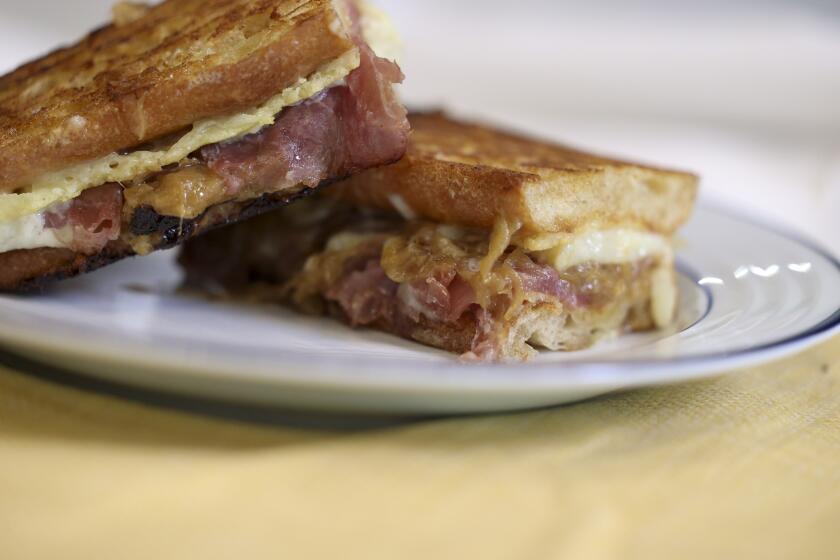Sweet autumn
FALL has always seemed an especially sweet season for me. When I was a kid I’d get a thrill seeing the neatly lined up boxes of fresh pencils and rows of unmarked notebooks in the stores. Not to mention the new season’s lunch boxes!
I feel the same way now about the fall fruits and vegetables overflowing the stands at farmers markets. Well, there is one difference: While the idea of new notebooks and pencils was irresistible, I wasn’t so crazy about what I’d have to do with them. I have no such qualms about fall produce.
Sweetness, in particular a specifically honeyed kind of sweetness, is one of autumn’s hallmarks. You find it in familiar crisp apples and melting ripe pears as well as in quinces, persimmons and, perhaps most emphatically, Asian pears, which sometimes taste so frankly of honey it seems like they must be coated with it.
Indeed, it seems appropriate that Rosh Hashana, the Jewish New Year that will be celebrated next week, has as part of its ritual the eating of a slice of apple dipped in honey.
If it wasn’t apples, though, it could have been grapes, like the late Thompson Seedless we’re getting that have hung on the vine until they’re golden. Or, perhaps even more appropriately, the first, semi-dried Barhi dates, which taste like nothing more than honey candy.
How comforting to have the new year begin at a time of such plenty, rather than in the bleakness of winter.
Besides having that particular honeyed flavor, fall also has other kinds of sweetness. A great fig, for example, has a taste and texture like an extremely concentrated jam. This throws off some people. Just recently, a farmer offered to give me a substantial discount on a box of perfect, nearly collapsing, soft figs because they weren’t as pretty as the firm (and almost certainly dry and starchy) ones. My wife insisted as a matter of ethics that I pay full price and not take advantage of his ignorance, and so, grudgingly, I did.
Fall’s sweetness isn’t limited to fruits. It’s there in some of the season’s vegetables as well: in late-summer holdovers such as red peppers and tomatoes and cool-weather crops like fennel, broccoli and cauliflower.
Sweetest of all, there is winter squash (so-called because its hard rind preserves it through the cold, even though it is harvested -- and most flavorful -- in autumn).
*
Nutty flavors
AND then there are the nuts, for which I go, well, you know. Fresh pistachios, such as those from Gail Zannon of Santa Barbara Pistachio Co. Almonds, sometimes still in their paper-soft shell. Walnuts so recently picked their meats are still a little creamy.
The other day at the Long Beach farmers market, one of my favorite growers, Joe Avitua from Walker Farms, pulled out a surprise from behind the counter: the first fresh-crop walnuts, still in their spicy scented green husks.
Welcome as it is, this sweet abundance can be a little overwhelming. Used injudiciously, it’s easy to wind up with a dish that’s just short of gooey. The trick is harnessing the sweet rather than letting it run away with the dinner, pairing it with partners that will keep it from getting cloying.
This is especially true when combining sweet ingredients with savory. While this is a hallowed fall tradition -- think of duck with figs, fish with grapes, foie gras with Sauternes -- it is to be approached with great caution. As wonderful as the combination can be, it can also turn into a train wreck of flavors.
Consider carefully what kinds of savories you’re going to pair with the sweets -- not everything works equally well. In general, the best rule is the fattier the food, the better.
Cheese is almost a category of its own. One of the real pleasures of fall dining is the return of a good cheese plate. And just as sweet wines provide the surest pairings with cheese, I try to include a sweet element with the cheese: either sliced fresh fruit, cooked-down essences like membrillo or even a dribble of something like slightly bitter chestnut or eucalyptus honey. And of course, a handful of fresh walnuts is always welcome.
Also, pairing sweet and savory ingredients entails more than just throwing them together in a pan. You have to carefully bring them together. There are several ways to do this.
*
Striking a balance
FIRST, of course, is remembering to balance the sweetness with acidity. Even the most luscious dish needs an element of rigor. Vinegar is one obvious solution, certainly not so much as to make your eyes sting, but just enough that it cuts through the fat and sweet and provides a kind of backbone for the dish. Fruits with high acidity work, too -- dried sour cherries, blackberries and raspberries or citrus.
Without a healthy shot of sweet-tart balsamic vinegar, braised duck legs with quince would taste simple and one-dimensional. It’s the acidity that throws the flavors into relief so you can appreciate them.
Texture is important, though we rarely think about it in this context. Foods that are sweet or fatty tend to seem a little flabby. Pair them with something crisp or crunchy. Raw vegetables such as fennel or watercress can provide this. So can ground nuts. Contrast soft pickled figs with crisp fennel.
All of these ideas apply to desserts as well as sweet-and-savory combinations. Sliced Fuyu persimmons taste simple until you dress them with tart lime juice, and split figs topped with whipped cream take on another dimension if you first drizzle a little liqueur over the fruit. At the same time, it’s the texture of the crisp crust of a fruit tart, or a crunchy almond topping over nearly melting baked Asian pears, that makes those dishes special.
Another key is finding a bridging flavor, a strong enough taste that provides a link between the sweet and savory, or at least distracts you so their differences are not so jarring. Even something so simple as sprinkling fresh parsley over the braised duck legs and quince changes the dish. Suddenly, it’s no longer about the contrast between sweet and sour, but about the harmony of the two.
The warm flavor of toasted nuts can do the same thing. This was brought home when I was preparing the fennel salad with pickled figs. It was good the first time I made it, when I tried using thin shards of salty ricotta salata as a bridge. But when I made it with toasted walnuts instead, the dish became something much, much better.
It’s the combination of all these elements that makes any dish -- great or small -- work. Think of the best apple you’ve ever tasted -- there is sweetness balanced by bright acidity and snappy crispness. Remove one of those elements -- dull the sweetness, dim the acidity or make it mushy in the mouth -- and even the best fall apple becomes just another mediocre piece of fruit.
With so much to celebrate this fall, would that be any way to start a new year?
*
Duck braised with quince and sour cherries
Total time: 1 hour, 50 minutes
Servings: 4
Note: During fall and winter, you can find fresh duck legs at many Asian markets such as 99 Ranch and specialty markets such as Bristol Farms and Whole Foods Markets. The rest of the year they’re available frozen, which works fine in this dish. Use a top-quality frozen beef stock. Sour cherries are sometimes labeled as tart. Serve this with herbed rice or couscous.
1 teaspoon black peppercorns
1/2 teaspoon whole allspice
3 whole cloves
4 duck legs
Salt
2 tablespoons oil
1 onion, minced (1 1/2 cups)
1 shallot, minced
1 cup red wine
1/4 cup balsamic vinegar
1 cup beef stock
2 tablespoons orange zest
2 medium quince (about 1 1/2 pounds)
1/3 cup dried sour cherries
2 tablespoons minced parsley
1. Heat the oven to 350 degrees. Grind the peppercorns, allspice and cloves to a fine powder in a spice grinder.
2. Rinse the duck legs and pat them dry. Cut away the backbone, if it is still attached (there’s almost no meat, but lots of bones). Lightly score the skin on both sides, cutting through the skin but not completely through the fat. Season liberally with salt and the spice mixture; rub it in.
3. Heat the oil in a large skillet over medium heat. When the oil is hot, add the duck legs, skin side down. Cook until quite brown, about 15 minutes, and then turn and cook the other side. The duck will stick at first, but the skin will release with a gentle jiggle when it has browned enough, so don’t force it. Also, don’t rush the process; in addition to browning the skin, this step renders a lot of fat. Because duck legs are quite large, you may need to do this in two steps or in two pans.
4. While the duck legs are browning and after they’ve rendered some of the fat, spoon about 3 tablespoons of the fat into the bottom of a large, heavy braising pan. Add the onion and cook over medium heat until soft, about 5 minutes. Add the shallot and cook another 3 or 4 minutes. Remove from heat and set aside until the duck legs are done.
5. When the duck legs have browned on both sides, transfer them to the braising pan, arranging them on top of the onions, with the “knees” facing the center. They may overlap slightly. Add the red wine, balsamic vinegar, beef stock and orange zest and bring to a gentle simmer. Place a sheet of aluminum foil over the legs, pressing lightly to minimize the amount of air. Cover and place in the oven for 30 minutes.
6. While the legs are cooking, peel, quarter and core the quince. Slice each quarter crosswise into 2 pieces.
7. When the duck legs have braised for 30 minutes, remove them from the oven. If there is fat floating on the surface of the liquid, skim as much as you can with a large spoon. Place the quince on top of the duck and give the pan a shake to settle them into the liquid. Season the braising liquid with salt to taste. Replace the foil and the lid and continue cooking until the duck is tender enough to be easily penetrated with a skewer and the quince is quite soft, about 40 to 45 minutes.
8. Gently stir in the dried sour cherries, replace the lid and let stand at room temperature until they soften slightly, about 5 minutes. Sprinkle with the minced parsley and serve immediately.
Each serving: 403 calories; 27 grams protein; 24 grams carbohydrates; 2 grams fiber; 18 grams fat; 4 grams saturated fat; 105 mg. cholesterol; 231 mg. sodium.
*
Fennel and red onion salad with pickled figs
Total time: 40 minutes plus pickling time
Servings: 6
Quick-pickled figs
1 1/2 cups water
1 1/2 cups red wine vinegar
1 cup sugar
1 (1 1/2 -inch) cinnamon stick
4 whole cloves
6 whole allspice
8 black peppercorns
12 fresh figs, purple or green (about 3/4 pound)
1. In a small saucepan, bring the water, vinegar, sugar, cinnamon, cloves, allspice and black peppercorns to a boil. Reduce the heat to a simmer and cook 10 minutes.
2. Place the figs in a bowl and pour the pickling mixture over. Let cool, then transfer to a plastic zipper storage bag. Let stand at least 1 1/2 hours at room temperature or refrigerate up to one week.
Salad and assembly
2 fennel bulbs
1 cup thinly sliced red onion (about 1/2 onion)
1/2 teaspoon whole coriander seed
2 tablespoons red wine vinegar
1/4 cup vegetable oil mixed with 2 tablespoons walnut oil
Salt
1/4 cup chopped walnuts
Quick-pickled figs
1. Trim the fennel branches from the bulbs and cut the bulbs in quarters lengthwise. Trim the solid core in the center and then slice the quarters lengthwise as thinly as you can.
2. Place the sliced red onion in a strainer and rinse under hot tap water. Pat dry.
3. Prepare the vinaigrette by toasting the coriander seeds in a small, dry pan over medium heat until it is fragrant, about 3 minutes. Grind the seeds fine in a mortar and pestle and stir in the vinegar. Slowly stir in the oil to make a smooth emulsion. Season with salt to taste.
4. Toast the walnuts in a small, dry pan over medium heat until they darken slightly and become fragrant, about 5 minutes (you can use the same pan as for the coriander seed).
5. Combine the fennel and the onion in a large mixing bowl. Pour the dressing over and toss to coat lightly.
6. Divide the salad evenly among 6 plates, mounding it in the center. Remove the tough stems from the pickled figs and slice the figs in quarters. Arrange the figs over each salad; scatter the toasted walnuts over the top, and serve.
Each serving: 324 calories; 3 grams protein; 44 grams carbohydrates; 6 grams fiber; 17 grams fat; 2 grams saturated fat; 0 cholesterol; 42 mg. sodium.
*
Asian pear crisp with almond topping
Total time: 1 hour, 35 minutes
Servings: 6
Note: The slivered almonds should be as fresh as possible; Trader Joe’s is a good source.
Butter
1/3 cup raisins
1/4 cup
Bourbon
2 tablespoons slivered
almonds
1/4 cup flour
2 tablespoons plus 1 teaspoon sugar, divided
1/4 teaspoon salt
1/4 cup ( 1/2 stick) chilled butter
3 Asian pears (about 1 1/2 to 1 3/4 pounds total)
2 tablespoons honey
1 tablespoon lemon juice
1/3 cup whipping cream
1. Heat the oven to 350 degrees. Generously butter 6 (one-half cup) ramekins or baking cups. Place the raisins in a small bowl and cover them with the Bourbon until they soften slightly, about 30 minutes. Place the almonds on a baking sheet and toast in the oven until they are fragrant and have darkened slightly, about 3 to 4 minutes.
2. To prepare the topping, combine the almonds, flour, 2 tablespoons sugar and the salt in the work bowl of a food processor. Pulse 2 or 3 times to chop the almonds coarsely; you don’t want them finely ground.
3. Cut the cold butter into cubes and scatter over the dry ingredients. Pulse until the butter is cut up into small clumps, about the size of peas. Do not over-process. Set aside.
4. Peel the pears and cut them in half lengthwise. Use a melon baller to scoop out the core and stem. Cut the pears in neat one-half-inch dice. You should have about 3 1/2 to 4 cups.
5. Place the diced pears in a large bowl and gently toss with the honey and lemon juice. Drain the raisins and add them to the bowl, reserving the Bourbon. Fold together gently to avoid breaking up the pears.
6. Spoon the pears into the prepared ramekins, filling all the way to the top (the filling will settle some during baking). Divide the topping and spoon evenly on top of the pears. Do not pat firm -- left a little loose it will make a crisper crust.
7. Bake until the top is evenly browned, about 1 hour. Cool slightly before serving.
8. While the baked crisps are cooling, whip the cream to form soft peaks. Beat in the remaining teaspoon of sugar and one-half teaspoon of the reserved Bourbon, discarding the rest.
9. Top each crisp with a small dollop of whipped cream and pass the rest of the cream at the table.
Each serving: 270 calories; 2 grams protein; 35 grams carbohydrates; 5 grams fiber; 14 grams fat; 8 grams saturated fat; 38 mg. cholesterol; 104 mg. sodium.
More to Read
Eat your way across L.A.
Get our weekly Tasting Notes newsletter for reviews, news and more.
You may occasionally receive promotional content from the Los Angeles Times.










